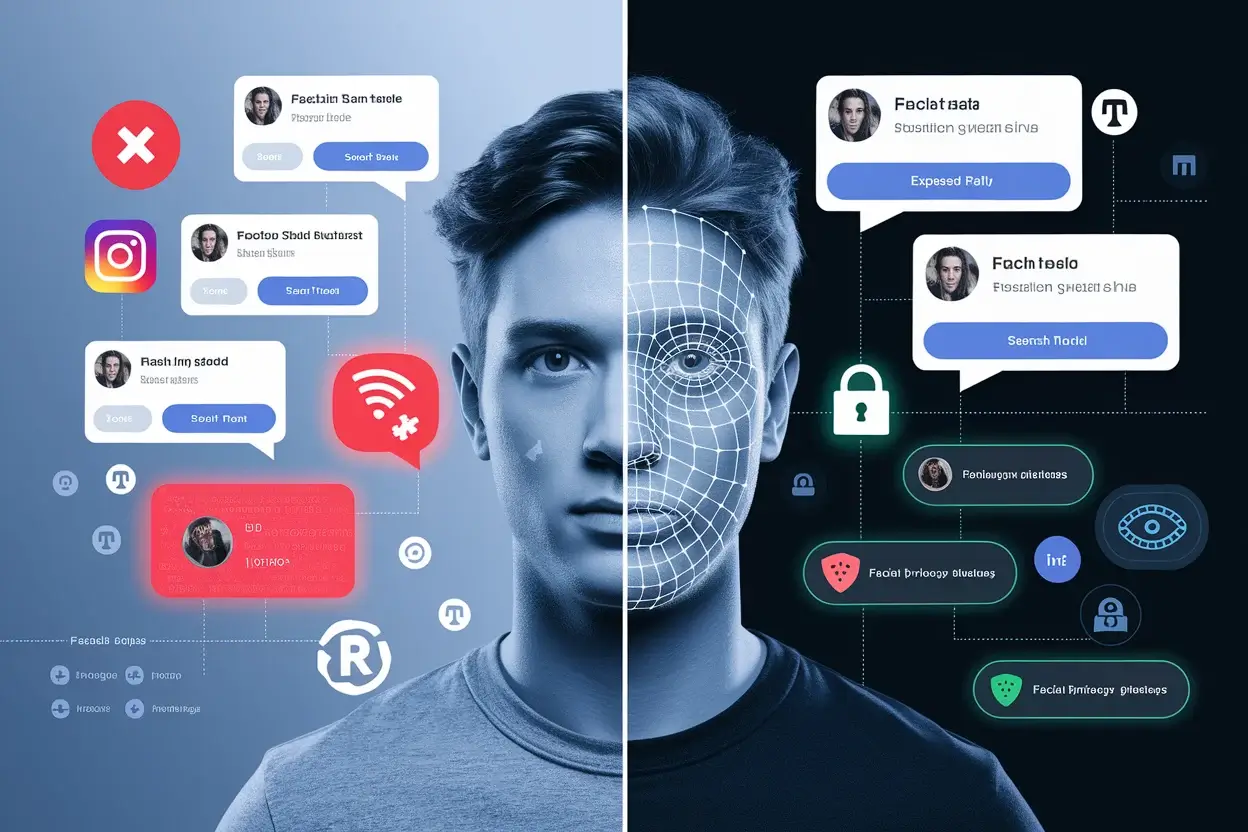Every photo you post, every friend who tags you, and every background appearance in someone else's content contributes to a vast digital map of your face across the internet. Social media platformsuse sophisticated facial recognition technology not just for tagging suggestions, but for advertising, content moderation, and data analytics.
This comprehensive guide reveals how your face is tracked across platforms and provides actionable steps to reclaim control over your facial privacy. You'll learn platform-specific settings, protection strategies, and legal rights that can help minimize your facial footprint online.
3.2B
Across major social platforms
2.8B
People with facial recognition profiles
85%
Reduction with proper settings
How Social Media Platforms Track Your Face
Understanding the mechanisms behind facial tracking helps you make informed decisions about your privacy:
Platforms automatically scan every uploaded photo to:
- Create facial templates for identification
- Suggest tags automatically
- Link faces across different photos
- Build social connection maps
Major tech companies share facial data between their platforms:
Meta Ecosystem:
- • Facebook ↔ Instagram
- • WhatsApp profile sync
- • Messenger integration
Google Services:
- • YouTube ↔ Google Photos
- • Android face grouping
- • Search integration
Platform-Specific Privacy Settings
Each platform has different privacy controls. Here's how to configure them for maximum protection:
Facebook & Instagram (Meta)
Face Recognition Settings:
- Settings → Privacy → Face Recognition: Turn OFF
- Timeline Review: Enable to approve tags before they appear
- Tag Suggestions: Disable automatic friend suggestions
Photo Privacy:
- Default photo audience: Set to "Friends" only
- Download prevention: Enable to prevent easy downloading
TikTok
- Privacy → Personalization: Turn off "Use for ads"
- Comments: Set to "Friends" to reduce exposure
- Duet/Stitch: Limit to prevent unauthorized use
- Download: Turn off to prevent face extraction
- Privacy → How others see your profile: Limit to connections
- Photo visibility: Set professional photos to connections only
- Data usage: Opt out of advertising personalization
Third-Party App Risks
- Photo editing apps with "beautify" features
- Dating apps that sync with social media
- Games requesting photo access
- Unknown quiz or personality test apps
- Regular app permission audits
- Revoke unused app connections
- Read privacy policies before connecting
- Use separate email for app sign-ups
Advanced Protection Strategies
Photo Sharing Best Practices
Before Posting:
- Review all faces in group photos
- Get consent from others before tagging
- Consider using photo filters strategically
- Remove EXIF data before uploading
Content Strategy:
- Limit full-face close-up photos
- Use sunglasses or accessories strategically
- Focus on activities rather than faces
- Consider artistic angles and lighting
Technical Protection Methods
Adversarial Patterns:
Subtle digital patterns added to photos that confuse facial recognition algorithms while remaining invisible to humans.
Face Obscuration Tools:
- • Signal's face blur feature
- • GIMP privacy filters
- • Online face scrambling tools
- • Strategic makeup patterns
Audit Your Digital Footprint
Regular audits help you understand and control your facial presence across the internet:
Step-by-Step Audit Process:
Search Yourself
Use FaceSearch AI and other reverse image search tools to find where your face appears online.
Review Platform Activity
Check all social media platforms for unexpected tags, mentions, or appearances.
Connected Apps Review
Audit all third-party applications with access to your social media accounts.
Data Download Analysis
Download your data from major platforms to see what facial information they've collected.
Your Legal Rights and Removal Options
Understanding your legal rights regarding facial recognition and photo removal is crucial for protecting your privacy:
- Right to erasure: Request deletion of facial data
- Right to object: Oppose facial recognition processing
- Data portability: Request your facial data in portable format
- CCPA (California): Right to delete personal information
- BIPA (Illinois): Biometric data protection requirements
- VTPA (Virginia): Consumer data protection rights
Platform Removal Procedures:
Taking Control of Your Digital Face
Your face is one of your most personal identifiers, and protecting it online requires ongoing vigilance and the right strategies. By implementing the privacy settings, protection methods, and monitoring practices outlined in this guide, you can significantly reduce your facial footprint across social media platforms.
